Dryocopus martius
IUCN
LCBasic Information
Scientific classification
- name:Dryocopus martius
- Scientific Name:Dryocopus martius,Black Woodpecker
- Outline:Climbing birds
- Family:Picipitidae Picidae B.Woodpecker
Vital signs
- length:41.5-46.8cm
- Weight:325-352g
- lifetime:About 11 years
Feature
It is the largest woodpecker and is almost pure black.
Distribution and Habitat
Distributed in Albania, Andorra, Armenia, Austria, Azerbaijan, Belarus, Belgium, Bosnia and Herzegovina, Bulgaria, China, Croatia, Czech Republic, Denmark, Estonia, Finland, France, Georgia, Germany, Greece, Hungary, Islamic Republic of Iran, Italy, Japan, Kazakhstan, Democratic People's Republic of Korea, South Korea, Latvia, Liechtenstein, Lithuania, Luxembourg, Macedonia, Moldova, Mongolia, Montenegro, Netherlands, Norway, Poland, Romania, Russian Federation, Serbia, Slovakia, Slovenia, Spain, Sweden, Switzerland, Turkey, Ukraine.
Wandering: Portugal.
Inhabits coniferous and beech forests in temperate Eurasia, preferring large coniferous or deciduous forests, including all forest species (beech, fir, larch, pine). It is a resident bird in the subalpine coniferous forests of the eastern Qinghai-Tibet Plateau in China. It is active in lowlands in the north to 2400 meters above sea level in the south. It mainly inhabits the original coniferous forest and mixed coniferous and
Appearance
The black woodpecker is very large. The forehead, top of the head and the back of the nape of the male bird are vermilion, and the crest is also vermilion. The ear feathers and upper back are black with a slight touch of brilliant green; the lower back, waist, upper tail coverts, wing coverts and flight feathers are brilliant black-brown; the tail feathers are also black-brown, and the feather shaft has a metallic luster. The chin, throat, and cheeks are dark brown, and the rest of the lower body is black-brown. The bill is wedge-shaped; the nostrils are feathered; there are 4 toes. The first primary flight feather is very small, less than 1/2 of the second one.
The female bird is similar to the male bird, but the feather color is slightly lighter, and only the back of the head is vermilion.
The plumage of the juvenile bird is lighter than that of the adult bird. The forehead and top of the head are dark brown, and the nape is red, which is not as bright as the adult bird. The re
Details
The black woodpecker is called Black Woodpecker in foreign language, and has 2 subspecies.
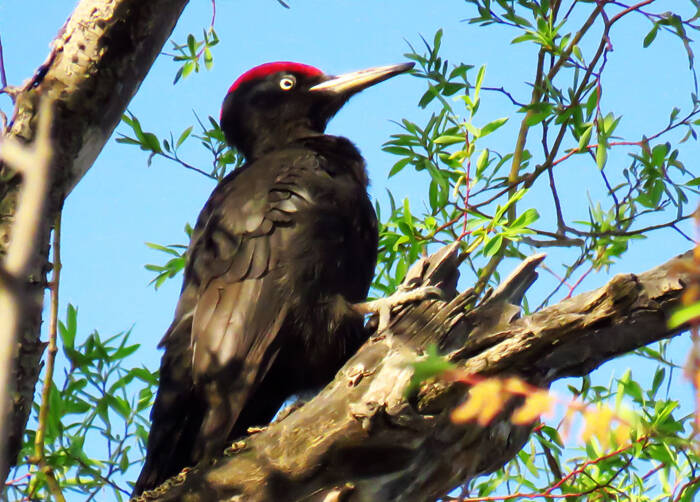
The black woodpecker's flight is not stable, but not as undulating as other woodpeckers. It often acts alone. In the late breeding period, it forms a family group. It mainly feeds on tree branches, thick branches and dead trees, and often forages for ants and insects on the ground and decaying fallen trees. In summer, it mainly feeds on adult ants, larvae, eggs, golden electrons, click beetles and other insects, eggs and pupae. In winter, it mainly feeds on longhorn beetle larvae that hibernate in tree trunks. It mainly feeds on ants, and digs large holes when eating.
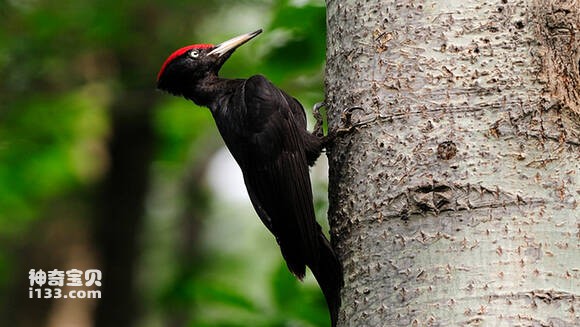
About 99% of the black woodpecker's food is ants, and it also eats beetle and butterfly larvae, caterpillars, and fly maggots. The preferred feeding ground is dead or dying trees, and dead leaves lying on the stump bed. In winter, when ants make a large-scale evacuation, they also eat bees that hibernate away from the hive, and occasionally eat fruits, berries and other birds, even bird eggs and small birds.
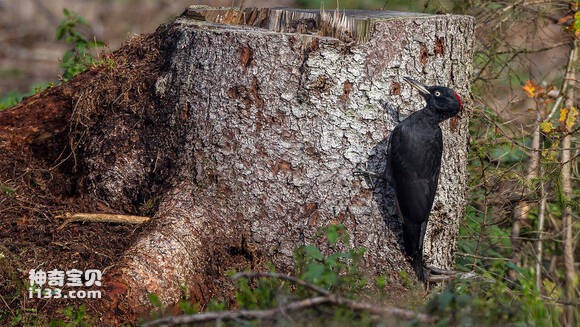
When foraging, black woodpeckers often peck at tree trunks with their beaks, and the pecking sound can be heard from a long distance. They fly in waves, often from one tree to another. Normally, the calls are few and monotonous, and the sounds are similar. During the breeding season, the calls increase and are slightly tortuous. When warning or flying, they make a loud "krri-krri-krri" sound or a clear "klee-ay" sound. In spring, they make a loud "kwee-kwee-kwee-kwee-kwee-kwee-kwee" sound with a continuous tail sound. It is also called a nasal gurgling sound. The loud chiseling sound lasts for 2-3 seconds.
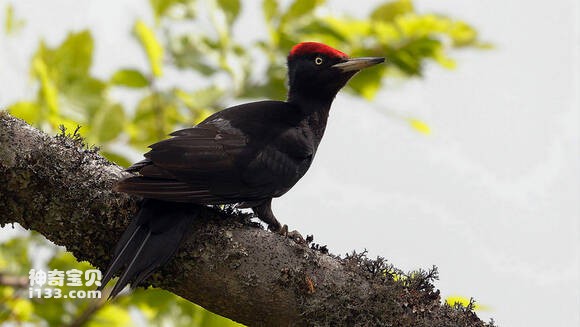
The breeding season of the black woodpecker is from April to June. It nests in tree holes. The hole nests are mostly chosen on tall dead trees and dead trees, rather than on living trees. Generally, they are chosen on dead trees with rotten heartwood. The hole is 5-15 meters above the ground, located in the middle and upper layers of the tree trunk; the hole is rectangular, which is obviously different from other woodpeckers. The hole size is 7.5-8.5×12-14 cm; the inner diameter of the hole is 20-30 cm; the depth of the hole is 42-48 cm. The nest hole is pecked by male and female birds together. Each nest lays 3-9 eggs, which are white, smooth and spotless, oval, and 30.5-27 mm in size. The male and female birds take turns to incubate the eggs, and the incubation period is 12-14 days. The chicks are late-maturing and need to be fed by the parents for 24-28 days before they can leave the nest and fly. During the brooding period, they are also the time to eliminate pests in large numbers.
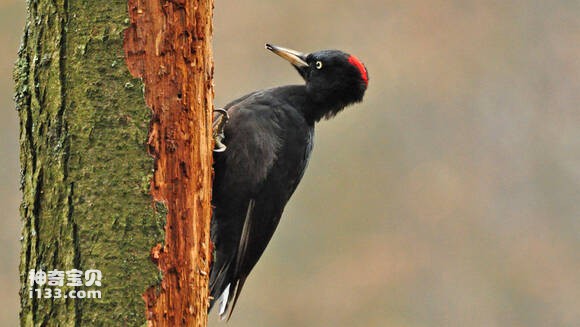
Listed in the "Red List of Threatened Species of the World Conservation Union" (IUCN) 2016 ver 3.1-Least Concern (LC).
Listed in the second level of China's "National Key Protected Wildlife List" (February 5, 2021).
Protect wild animals and stop eating game.
Maintaining ecological balance is everyone's responsibility!








